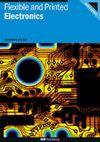结构化铜和印刷银混合可拉伸电子系统的力学性能
IF 3.2
4区 工程技术
Q3 MATERIALS SCIENCE, MULTIDISCIPLINARY
引用次数: 0
摘要
可拉伸电子器件可以使用不同的制造方法及其混合物来实现。后者的一个例子是将可拉伸电路板与丝网印刷相结合,这将在本工作中进行讨论。混合可拉伸电子结构基于光刻结构和刚性铜岛以及丝网印刷银墨互连。这使得能够将具有大量接触的部件组装到铜岛上以及岛之间的可变形银墨线。由于局部应力集中,岛和线之间的过渡区域至关重要。通过测量机械负载下测试互连的电阻,研究了影响和潜在的缓解措施。第一组样品在拉伸试验中被拉伸至30%。在高达10000次循环的循环测试中,第二组样品被拉长了10%、20%和30%。试验后,进行了广泛的失效分析,如扫描电子显微镜和有限元分析。在最大载荷下的拉伸试验中,过渡区域的互连要么断裂,要么电阻增加640%。在过渡区域周围添加保护结构,电阻增加可以减少到12%。过渡区的应力集中可以通过结构的布局来控制,如循环试验所示。根据布局,结构保护过渡区的互连(在10000次循环中,10%和20%的电阻<4Ω,在30%的伸长率下,最高可达5000次循环),或采用特定设计,会对电路造成致命损坏并提前失效。所识别的失效机制通常是由保护结构的重复弯曲引起的疲劳损伤。在界面处观察到的电阻增加与保护结构中的裂纹扩展阶段密切相关。本文章由计算机程序翻译,如有差异,请以英文原文为准。
Mechanical properties of structured copper and printed silver hybrid stretchable electronic systems
Stretchable electronics can be realized using different manufacturing methods and hybrids thereof. An example of the latter is the combination of stretchable circuit boards with screen-printing, which will be discussed in this work. The hybrid stretchable electronics structures are based on photolithographically structured and rigid copper islands and screen-printed silver ink interconnections. This enables the assembly of components with a high number of contacts onto the copper islands and deformable silver ink lines between islands. The transition area between islands and lines is critical due to local stress concentration. The effect and potential mitigations were studied by measuring the electrical resistance of test interconnections under mechanical loading. The first set of samples was elongated up to 30% in tensile tests. The second set of samples was elongated 10%, 20%, and 30% in cyclic tests up to 10 000 cycles. After the tests, extensive failure analysis, e.g. scanning electron microscope, and finite element analysis were conducted. In tensile tests at maximum load, the interconnections either snap apart or their resistance increases by 640% in the transition area. Adding protective structures around the transition area, the resistance increase can be reduced to 12%. Stress concentration in the transition area can be controlled with the layout of the structures, as shown in the cyclic tests. Depending on a layout, the structures protect interconnections in the transition area (resistance <4 Ω at 10% and 20% throughout 10 000 cycles, and up to 5000 cycles at 30% elongation), or with particular designs, cause fatal damage of the circuitry and fail early. The identified failure mechanism is typically fatigue damage caused by the repeated bending of the protective structure. The observed resistance increase at the interface was closely related to the crack propagation phase in the protective structures.
求助全文
通过发布文献求助,成功后即可免费获取论文全文。
去求助
来源期刊

Flexible and Printed Electronics
MATERIALS SCIENCE, MULTIDISCIPLINARY-
CiteScore
4.80
自引率
9.70%
发文量
101
期刊介绍:
Flexible and Printed Electronics is a multidisciplinary journal publishing cutting edge research articles on electronics that can be either flexible, plastic, stretchable, conformable or printed. Research related to electronic materials, manufacturing techniques, components or systems which meets any one (or more) of the above criteria is suitable for publication in the journal. Subjects included in the journal range from flexible materials and printing techniques, design or modelling of electrical systems and components, advanced fabrication methods and bioelectronics, to the properties of devices and end user applications.
 求助内容:
求助内容: 应助结果提醒方式:
应助结果提醒方式:


